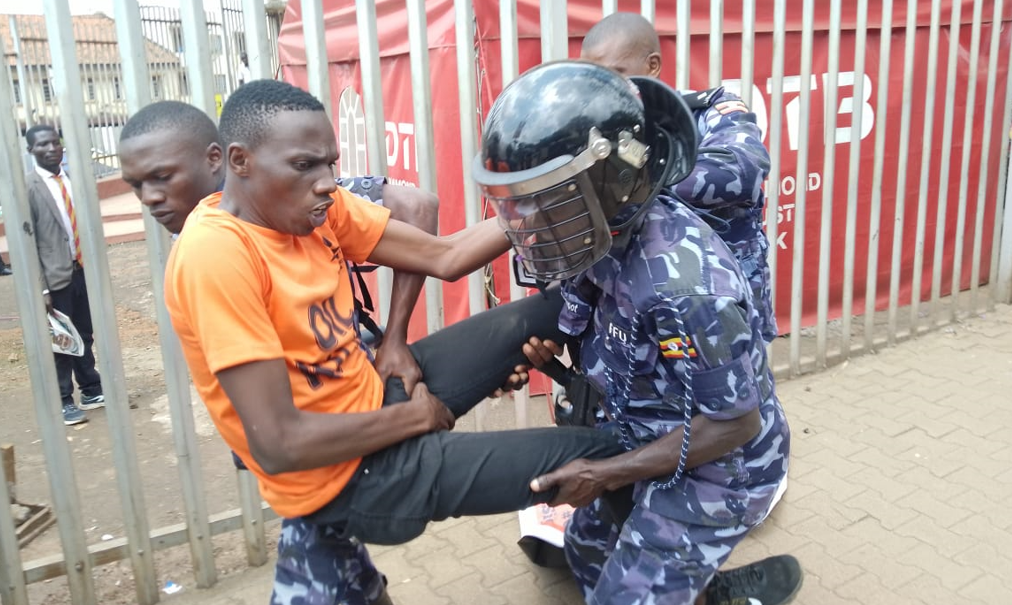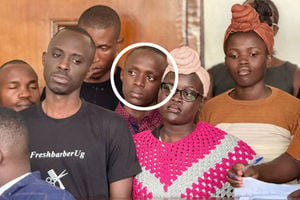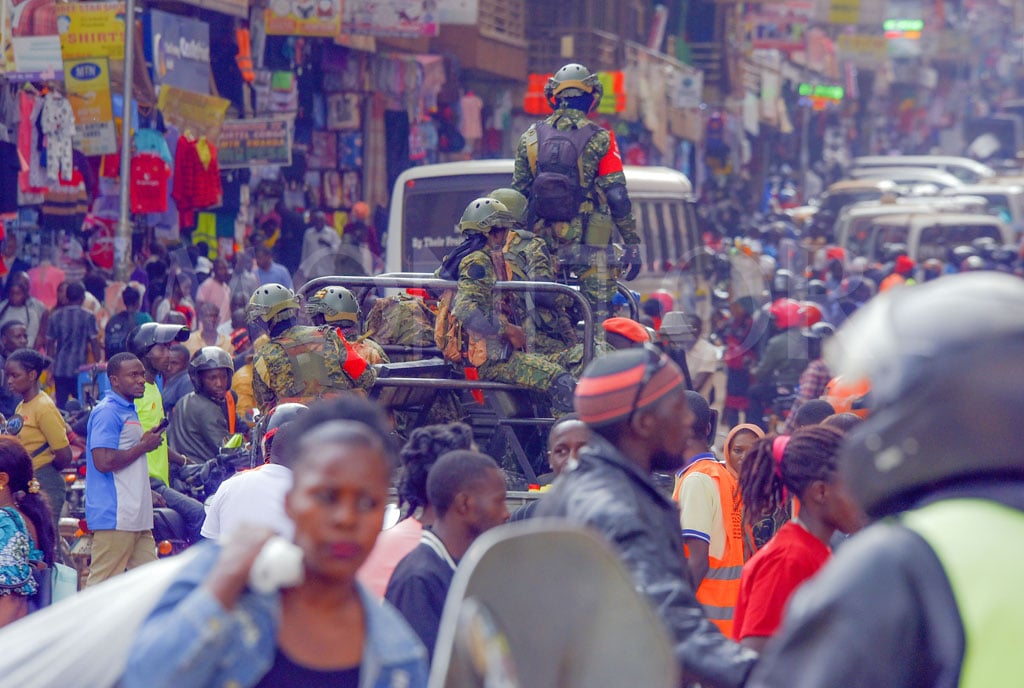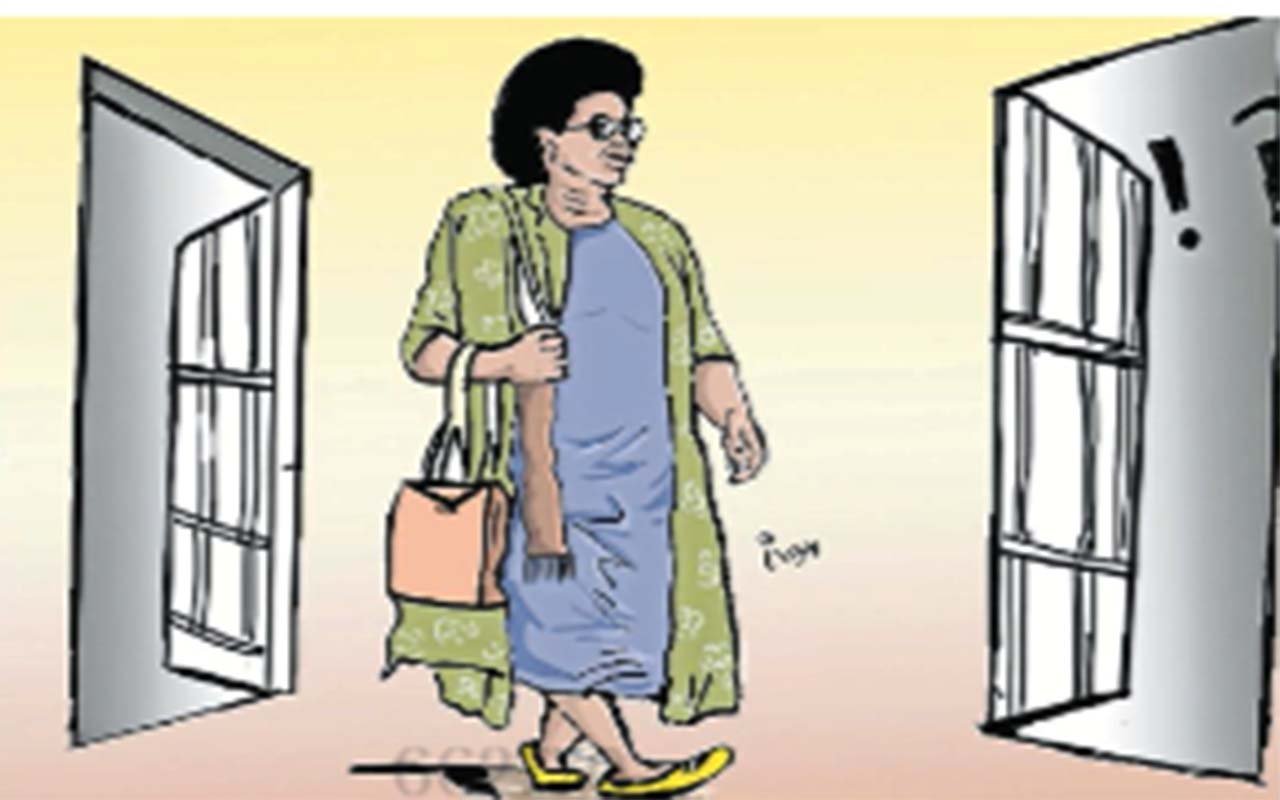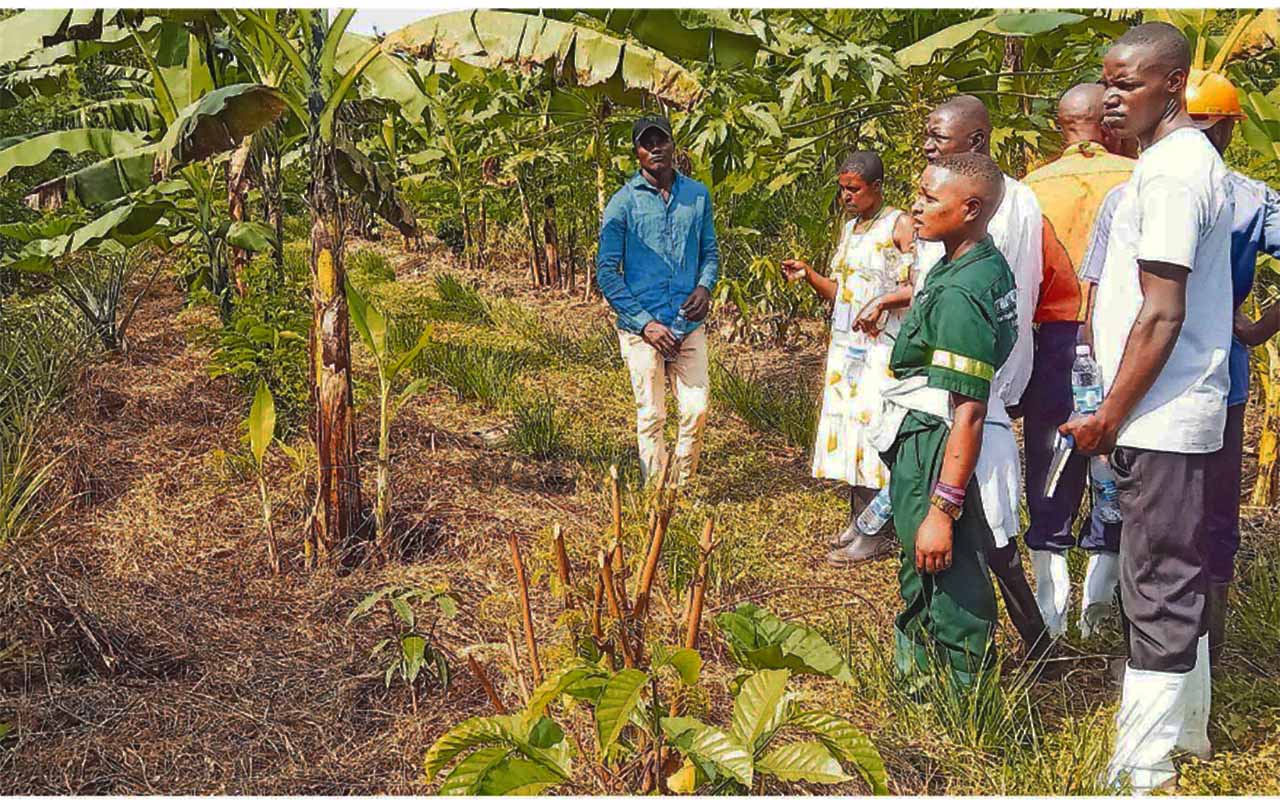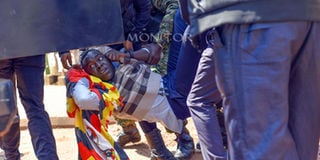
Police arrest a protestor in Kampala during last month’s #MarchToParliament demonstrations against corruption. PHOTOS | MICHEAL KAKUMRIIZI
On August 1, a video of both uniformed and plain-clothed police officers roughing up striking medical interns went viral.
The same day, Sky News was carrying televised images of processions of demonstrators in various cities of Nigeria who had taken to the streets at the start of a planned 10-day protest dabbed “days of rage” which were called to protest a sharp increase in the cost of living.
The stage for the demonstration was set by the Nigerian government’s decision to scrap fuel subsidies. That sent pump prices through the roof, a development which had a ripple effect on transport and consumer goods.
Same fatigues, different actions
If the images on Sky News are anything to go by, police officers in Nigeria adorn sets of uniforms that are very similar to those that officers of the Uganda Police Force do. One set of uniforms is very similar to the one that the Counter Terrorism Unit (CTU) adorn, while another set is similar to the black and blue adorned by the Field Force Unit.
The uniforms are, however, the only thing that the two forces had in common, at least by their actions.
Both police forces may have been playing out their stuff on the same continent, but one could by their different approaches to the demonstrations and demonstrators, be forgiven if they were to believe that these were two different forces operating on two different continents.
The Nigerian officers could be seen marching beside the demonstrators. They were there to ensure that the demonstrators stuck to the roads and did not interfere with the freedom of other Nigerians who had chosen not to participate.
The Ugandan officers, on the other hand, were seen running after intern doctors with an energy akin to what one would expect a law enforcement officer to expend on the pursuit and apprehension of a suspect in a capital offence such as murder.
Before that, images of police officers roughing up protesters and in other cases stripping them naked went viral in a week in which several youth took to the streets of Kampala to protest widespread corruption in government.
The speed at which some of the officers charged at the unarmed youth, grabbed the manila placards from them and forced them to sit on the tarmac was as amazing as it was disturbing.
Mr Kituuma Rusoke, the spokesperson of the Uganda Police Force, would have you believe that the medical interns and the anti-corruption demonstrators had invited the violence upon themselves. He says there was a belligerent tone to their calls.
“(For) the demonstration against corruption event, the packaging of their calls was defeating their purpose. Somebody says everybody wherever you are come from wherever you are and we occupy the streets of Kampala. That alone defeats it,” Mr Rusoke says.
Repeat offenders
That talk about belligerence is, however, only a matter of conjecture. There has been no evidence whatsoever to suggest the kind of belligerence that he alludes to.
Besides, this was not the first time that Ugandans have seen the police “go native”. And like those other times before, the excuse seemed to be that the demonstrators appeared or sounded “belligerent”. This calls into question the level of preparedness of the force to police demonstrations.
Writing in the paper, Policing Demonstrations, which was published in the Law Enforcement Bulletin of August 1989, the former chief of the New York Police Department (NYPD), Mr Robert J. Johnson, and NYPD Captain Lawrence F Loesch Jr, say proper handling of demonstrators and respecting the rights of everyone should inform the actions of police officers deployed to police demonstrations.
“The proper handling of demonstrations is a major concern of law enforcement, especially since the constitution guarantees freedom of speech and the right of the people to assemble peacefully,” they wrote.
They add, “Protecting the rights of everyone involved and maintaining order has become the responsibilities of the police who pledge to uphold the constitution when taking the oath of office.”
Whereas the two officers were making reference to the constitution of the United States, our own Constitution also guarantees freedom of speech and the right of the people to assembly peacefully and protest.
Article 29 of the Constitution of Uganda gives the citizenry the freedom of speech and expression as well as the freedom to publicly assemble and demonstrate in a peaceful manner, but police has been standing in the way of the citizenry’s enjoyment of those rights.

Police patrol the streets of Kampala during last month’s protests against corruption
Whereas the Force has at times looked the other way during demonstrations organised by officials and politicians attached to the ruling National Resistance Movement (NRM), the Force has been uncompromising when it comes to events organised by the political Opposition or those that appear to be critical of the government and its policies.
That has opened up the Force to a raft of accusations of, including disrespect for the law, selective application of the law and working in breach of the Constitution all of which, Mr Kituuma Rusoke denies.
“No security or law and order person can tell you that they do not know that Article 29 of the Constitution gives people the right to freedom of assembly and to demonstrate with others peacefully and unarmed. We do not contest those rights. Our disagreement has always been on the methodology (of the organisers),” he says.
Disrespect?
That position has always been debunked by the Opposition and scholars of the law. Constitutional lawyer Dan Wandera Ogalo told Sunday Monitor in a previous interview that the problem has always been down to the failure of the relevant institutions, including the police, to respect and observe the rule of law.
“We are not bothered by the law. Otherwise, the question of unlawful assembly, the question of demonstrations, was settled by the Constitutional Court in the case Muwanga Kivumbi vs the Attorney General. The court laid down exactly what is supposed to happen. First and foremost, you do not need the permission of police to assemble. It is simply because police do not want to accept the law,” Mr Ogalo says.
On May 27, 2008, the Constitutional Court ruled that Section 32(2) of the Police Act which the Force had been invoking to block public assemblies and demonstrations was inconsistent with Article 29(1) of the Constitution, which guarantees freedom of association, including the right to demonstrate.
The judges ruled that empowering the Inspector General of Police (IGP) to prohibit assemblies “contravened the fundamental rights to freedom of assembly and to demonstrate together with others peacefully”.
In 2020, the same court struck down Section 8 of the Public Order Management Act (POMA) which had returned those powers to the IGP, but police continue to stop peaceful demonstrations and public gatherings, a position which Mr Rusoke defends, insisting that police have to regulate them.
“The police are mandated to regulate you as you exercise your right. You are supposed to meet with it and plan with it. Besides this is not an absolute right. It has limits and the Force has a duty to see to it that you do not overstep those limits,” he says.
Questionable methods
The biggest contention has, however, been the often diabolical methods that the Force has employed to “regulate the gatherings”.
Compared to the actions of their Nigerian counterparts who we earlier alluded to, it would appear that the officers of the Uganda Police are incapable of policing demonstrations with either civility or common decency.
On April 28, 2011, for example, Gilbert Bwana Arinaitwe smashed the windscreen of Dr Besigye’s car and sprayed his eyes with pepper before bundling him onto a police pick-up truck.
On April 12, 2012, police officers who were arresting Ms Ingrid Turinawe squeezed her breast, in an incident that was described by the then IGP, Gen Kale Kayihura, as “a small matter”.
There have also been images of people being stripped naked during arrest; violent raids on Parliaments; beating of Members of Parliament (MPs) and; beating and knocking Opposition supporters with police cars. The list of violent acts goes on and on.
There have been so many incidents of use of excessive force that one wonders whether the Force puts adequate effort into educating its officers on the rules of engagement, but Mr Rusoke says the Force does emphasise it.
“You cannot condemn the training because the police modules on rules of engagement are very clear,” he says.
Mr Julius Odwe, a retired Deputy IGP, says no officer should be carrying out violent arrests because the law presupposes that everyone is innocent until proven guilty. He thinks that some officers might not be up to speed on the use of reasonable force.
“The police need to know what reasonable force is. If you beat a person who has been obeying you is not a reasonable force. That is a criminal act or an act of indiscipline on the part of the police officer,” he says.
Escalation
On escalation, Mr Odwe says there are five levels of action that police must take before declaring the situation volatile and as such necessitating the use of firearms.
“The first level is to talk to the gathering and tell them the wrong they are doing. That goes along with advice on what they should do. The second level is to order or push them out. The third is to arrest. The fourth is the use of reasonable force, but that is usually when the demonstrators have turned violent. However, this fourth one also has different levels like green, yellow, brown and red. Red means that the situation is very volatile,” Mr Odwe argues.
There is little evidence to suggest that the police ever goes through those steps as elaborated by the retired Deputy IGP.
The violent manner in which the anti-corruption demonstrators and intern doctors were dealt with suggests that violent conduct on the part of the police is not about to end, but where is the problem?

Police spokesperson Kituuma Rusoke addresses journalists in Kampala on July 22, 2024. PHOTO/PRISCILLA MALOBA
Training deficiencies?
Mr Johnson and Mr Loesch Jr argue in their paper that, “The key to handling a demonstration successfully is trained and experienced law enforcement personnel.”
So could the flagrant abuse of rights and involvement in acts of violence suggest inadequacies in training? Mr Odwe thinks so.
“The question of human rights is automatic and mandatory. It is the first thing that police must be told. When we joined the police there was what was called the police law examination. You would be in the field for five years and then be re-examined to establish how much you have understood the law, because the law in the classroom is theoretical, while the law in the field is practical,” he says.
Mr Kituuma Rusoke does not agree.
“When you say a deficit in training, it would insinuate that the models are lacking, which I disagree with. I would compare it to when we go to school. The teachers will train, but at the end of the course, there are people who will get 9s,” he says.
Inadequate preparations
Mr Odwe adds that if the public is witnessing constant lapses and errors in judgment on the part of the police, it is because not enough effort has been committed to the preparation and development of the officers.
“People are recruited from different communities and backgrounds. They have different cultures and education. Others can be bad, but it is the police to transform them. The transformation begins in the training schools, but that is not where it ends. It ends in the field,” Mr Odwe argues.
He adds, “Transforming a character into a good law enforcement officer is a process that takes time, but it should be a progression towards value. If somebody was like 50 percent good, he should over time progress to 75 percent, 80 percent or even beyond. They should not be at 50 percent and then regress to 40 or 25.”
Mr Rusoke insists that there is nothing wrong with the police’s current processes of training and development of officers. He also adds that officers are often given briefings before deployments for policing demos, but that a few officers will still turn rogue.
“An average officer is trained on the rules of engagement and the proportionality of force, but sometimes we have situations where an officer as an individual, has poor appreciation of the situation. We cannot run away from those incidents, but on the whole, officers are briefed on the nature of engagements,” he says.
How many more debriefs will it take before they stop roughing up demonstrators?
